DyMnO3: Synthesis, Characterization and Evaluation of Its Photocatalytic Activity in the Visible Spectrum
Abstract
:1. Introduction
2. Materials and Methods
2.1. Synthesis
2.1.1. Precursor Optimization
2.1.2. Temperature Optimization
2.2. Characterization of DyMnO3 Powders
2.3. Photocatalytic Activity
2.4. Transient Photocurrent Tests
3. Results and Discussion
3.1. X-ray Diffraction
3.2. Transmission Electron Microscopy
3.3. Porosity Analysis
3.4. UV-Vis Spectroscopy
3.5. Transient Photocurrent Measurements
3.6. Degradation of Malachite Green (MG) Dye
3.6.1. Photodegradation Kinetics
3.6.2. Recycling Tests and pH Influence
3.6.3. XPS Analysis
3.6.4. Contribution of Reactive Oxygen Species to the Photodegradation of the MG Dye
3.6.5. Photodegradation Mechanism
3.7. Photocatalyst Oxides Used in the Degradation of MG Dye
4. Conclusions
Author Contributions
Funding
Institutional Review Board Statement
Informed Consent Statement
Data Availability Statement
Acknowledgments
Conflicts of Interest
References
- Žužić, A.; Ressler, A.; Macan, J. Perovskite oxides as active materials in novel alternatives to well-known technologies: A review. Ceram. Int. 2022, 48, 27240–27261. [Google Scholar] [CrossRef]
- Stolz, A. Basic and applied aspects in the microbial degradation of azo dyes. Appl. Microbiol. Biotechnol. 2001, 56, 69–80. [Google Scholar] [CrossRef]
- Rauf, M.A.; Ashraf, S.S. Fundamental principles and application of heterogeneous photocatalytic degradation of dyes in solution. Chem. Eng. J. 2009, 151, 10–18. [Google Scholar] [CrossRef]
- Saeed, M.; Muneer, M.; Haq, A.u.; Akram, N. Photocatalysis: An effective tool for photodegradation of dyes—A review. Environ. Sci. Pollut. Res. 2022, 29, 293–311. [Google Scholar] [CrossRef]
- Pérez-Estrada, L.A.; Agüera, A.; Hernando, M.D.; Malato, S.; Fernández-Alba, A.R. Photodegradation of malachite green under natural sunlight irradiation: Kinetic and toxicity of the transformation products. Chemosphere 2008, 70, 2068–2075. [Google Scholar] [CrossRef] [PubMed]
- Srivastava, S.; Sinha, R.; Roy, D. Toxicological effects of malachite green. Aquat. Toxicol. 2004, 66, 319–329. [Google Scholar] [CrossRef] [PubMed]
- López-Alvarez, M.Á.; Silva-Jara, J.M.; Silva-Galindo, J.G.; Reyes-Becerril, M.; Velázquez-Carriles, C.A.; Macías-Rodríguez, M.E.; Macías-Lamas, A.M.; García-Ramírez, M.A.; López de Alba, C.A.; Reynoso-García, C.A. Determining the Photoelectrical Behavior and Photocatalytic Activity of an h-YMnO3 New Type of Obelisk-like Perovskite in the Degradation of Malachite Green Dye. Molecules 2023, 28, 3932. [Google Scholar] [CrossRef] [PubMed]
- Grabowska, E. Selected perovskite oxides: Characterization, preparation and photocatalytic properties—A review. Appl. Catal. B Environ. 2016, 186, 97–126. [Google Scholar] [CrossRef]
- Silva, G.R.O.; Santos, J.C.; Martinelli, D.M.H.; Pedrosa, A.M.G.; de Souza, M.J.B.; Melo, D.M.A. Synthesis and Characterization of LaNixCo1-xO3 Perovskites via Complex Precursor Methods. Mater. Sci. Appl. 2010, 1, 39–45. [Google Scholar] [CrossRef]
- Bhoi, K.; Dam, T.; Mohapatra, S.R.; Patidar, M.M.; Singh, D.; Singh, A.K.; Vishwakarma, P.N.; Babu, P.D.; Siruguri, V.; Pradhan Dillip, K. Studies of magnetic phase transitions in orthorhombic DyMnO3 ceramics prepared by acrylamide polymer gel template method. J. Magn. Magn. Mater. 2019, 480, 138–149. [Google Scholar] [CrossRef]
- Patra, M.; Midya, A.; Mandal, P. Investigation of large dielectric permittivity and relaxation behavior of DyMnO3 single crystal. Solid State Commun. 2022, 353, 114845. [Google Scholar] [CrossRef]
- Tajiri, T.; Terashita, N.; Hamamoto, K.; Deguchi, H.; Mito, M.; Morimoto, Y.; Konishi, K.; Kohno, A. Size dependences of crystal structure and magnetic properties of DyMnO3 nanoparticles. J. Magn. Magn. Mater. 2013, 345, 288–293. [Google Scholar] [CrossRef]
- Balli, M.; Mansouri, S.; Jandl, S.; Fournier, P.; Dimitrov, D.Z. Large rotating magnetocaloric effect in the orthorhombic DyMnO3 single crystal. Solid State Commun. 2016, 239, 9–13. [Google Scholar] [CrossRef]
- Midya, A.; Das, S.N.; Mandal, P.; Pandya, S.; Ganesan, V. Anisotropic magnetic properties and giant magnetocaloric effect in antiferromagnetic R MnO3 crystals (R = Dy, Tb, Ho, and Yb). Phys. Rev. B 2011, 84, 235127. [Google Scholar] [CrossRef]
- Valian, M.; Khoobi, A.; Salavati-Niasari, M. Green synthesis and characterization of DyMnO3-ZnO ceramic nanocomposites for the electrochemical ultratrace detection of atenolol. Mater. Sci. Eng. C 2020, 111, 110854. [Google Scholar] [CrossRef] [PubMed]
- Aman, S.; Tahir, M.B.; Ahmad, Z.; Znaidia, S.; Ahmad, N.; Khosa, R.Y.; Waheed, M.S.; Manzoor, S.; Abdullah, M.; Taha, T.A. Rational design of novel dysprosium manganite sandwich layered morphology for supercapacitor applications. Chin. J. Phys. 2022, 79, 531–539. [Google Scholar] [CrossRef]
- Carp, O.; Patron, L.; Ianculescu, A.; Pasuk, J.; Olar, R. New synthesis routes for obtaining dysprosium manganese perovskites. J. Alloys Compd. 2003, 351, 314–318. [Google Scholar] [CrossRef]
- Alonso, J.A.; Martínez-Lope, M.J.; Casais, M.T.; Fernández-Díaz, M.T. Evolution of the Jahn−Teller Distortion of MnO6 Octahedra in RMnO3 Perovskites (R = Pr, Nd, Dy, Tb, Ho, Er, Y): A Neutron Diffraction Study. Inorg. Chem. 2000, 39, 917–923. [Google Scholar] [CrossRef]
- Gülgün, M.A.; Nguyen, M.H.; Kriven, W.M. Polymerized Organic-Inorganic Synthesis of Mixed Oxides. J. Am. Ceram. Soc. 1999, 82, 556–560. [Google Scholar] [CrossRef]
- Das, B.; Das, B.; Das, N.S.; Sarkar, S.; Chattopadhyay, K.K. Tailored mesoporous nanocrystalline Ga2O3 for dye-selective photocatalytic degradation. Microporous Mesoporous Mater. 2019, 288, 109600. [Google Scholar] [CrossRef]
- Takahara, Y.; Kondo, J.N.; Takata, T.; Lu, D.; Domen, K. Mesoporous Tantalum Oxide. 1. Characterization and Photocatalytic Activity for the Overall Water Decomposition. Chem. Mater. 2001, 13, 1194–1199. [Google Scholar] [CrossRef]
- Sing, K.S.W. Reporting physisorption data for gas/solid systems with special reference to the determination of surface area and porosity (Recommendations 1984). Pure Appl. Chem. 1985, 57, 603–619. [Google Scholar] [CrossRef]
- Lowell, S.; Shields, J.E.; Thomas, M.A.; Thommes, M. Adsorption Mechanism. In Characterization of Porous Solids and Powders: Surface Area, Pore Size and Density; Particle Technology Series; Springer: Dordrecht, The Netherlands, 2004; Volume 16. [Google Scholar] [CrossRef]
- Chen, L.; Zheng, G.; Yao, G.; Zhang, P.; Dai, S.; Jiang, Y.; Li, H.; Yu, B.; Ni, H.; Wei, S. Lead-Free Perovskite Narrow-Bandgap Oxide Semiconductors of Rare-Earth Manganates. ACS Omega 2020, 5, 8766–8776. [Google Scholar] [CrossRef] [PubMed]
- Ju, Y.; Yang, S.; Ding, Y.; Sun, C.; Zhang, A.; Wang, L. Microwave-Assisted Rapid Photocatalytic Degradation of Malachite Green in TiO2 Suspensions: Mechanism and Pathways. J. Phys. Chem. A 2008, 112, 11172–11177. [Google Scholar] [CrossRef] [PubMed]
- Michel, C.R.; López-Alvarez, M.A.; Martínez-Preciado, A.H.; Oleinikov, V. Ultraviolet Detection and Photocatalytic Activity of Nanostructured LaCoO3 Prepared by Solution-Polymerization. ECS J. Solid State Sci. Technol. 2019, 8, Q9–Q14. [Google Scholar] [CrossRef]
- Michel, C.R.; Lopez-Alvarez, M.A.; Martínez-Preciado, A.H.; Carbajal-Arízaga, G.G. Novel UV Sensing and Photocatalytic Properties of DyCoO3. J. Sens. 2019, 2019, 1–12. [Google Scholar] [CrossRef]
- Rodríguez, C.I.M.; Álvarez, M.Á.L.; Rivera, J.d.J.F.; Arízaga, G.G.C.; Michel, C.R. α-Ga2O3 as a Photocatalyst in the Degradation of Malachite Green. ECS J. Solid State Sci. Technol. 2019, 8, Q3180–Q3186. [Google Scholar] [CrossRef]
- Modwi, A.; Abbo, M.A.; Hassan, E.A.; Al-Duaij, O.K.; Houas, A. Adsorption kinetics and photocatalytic degradation of malachite green (MG) via Cu/ZnO nanocomposites. J. Environ. Chem. Eng. 2017, 5, 5954–5960. [Google Scholar] [CrossRef]
- Tsvetkov, M.; Zaharieva, J.; Milanova, M. Ferrites, modified with silver nanoparticles, for photocatalytic degradation of malachite green in aqueous solutions. Catal. Today 2020, 357, 453–459. [Google Scholar] [CrossRef]
- Meena, P.L.; Poswal, K.; Surela, A.K. Facile synthesis of ZnO nanoparticles for the effective photodegradation of malachite green dye in aqueous solution. Water Environ. J. 2022, 36, 513–524. [Google Scholar] [CrossRef]
- Moulder, J.F.; Chastain, J.; King, R.C. (Eds.) Handbook of X-ray Photoelectron Spectroscopy: A Reference Book of Standard Spectra for Identification and Interpretation of XPS Data; Physical Electronics Division, Perkin-Elmer Corp: Eden Prairie, MN, USA, 1995. [Google Scholar]
- Suganya Josephine, G.A.; Ramachandran, S.; Sivasamy, A. Nanocrystalline ZnO doped lanthanide oxide: An efficient photocatalyst for the degradation of malachite green dye under visible light irradiation. J. Saudi Chem. Soc. 2015, 19, 549–556. [Google Scholar] [CrossRef]
- Chen, Y.; Zhang, Y.; Liu, C.; Lu, A.; Zhang, W. Photodegradation of Malachite Green by Nanostructured Bi2WO6 Visible Light-Induced Photocatalyst. Int. J. Photoenergy 2012, 2012, 510158. [Google Scholar] [CrossRef]
- Alharbi, A.; Abdelrahman, E.A. Efficient photocatalytic degradation of malachite green dye using facilely synthesized hematite nanoparticles from Egyptian insecticide cans. Spectrochim. Acta Part A Mol. Biomol. Spectrosc. 2020, 226, 117612. [Google Scholar] [CrossRef] [PubMed]
- Baeissa, E.S. Photocatalytic degradation of malachite green dye using Au/NaNbO3 nanoparticles. J. Alloys Compd. 2016, 672, 564–570. [Google Scholar] [CrossRef]
- Wei, Y.; Huang, Y.; Fang, Y.; Zhao, Y.; Luo, D.; Guo, Q.; Fan, L.; Wu, J. Hollow mesoporous TiO2/WO3 sphere heterojunction with high visible-light-driven photocatalytic activity. Mater. Res. Bull. 2019, 119, 110571. [Google Scholar] [CrossRef]
- Yadav, P.; Surolia, P.K.; Vaya, D. Synthesis and application of copper ferrite-graphene oxide nanocomposite photocatalyst for the degradation of malachite green. Mater. Today Proc. 2021, 43, 2949–2953. [Google Scholar] [CrossRef]
- Liu, Y.; Ohko, Y.; Zhang, R.; Yang, Y.; Zhang, Z. Degradation of malachite green on Pd/WO3 photocatalysts under simulated solar light. J. Hazard. Mater. 2010, 184, 386–391. [Google Scholar] [CrossRef]
- Luo, D.; Kang, Y. Synthesis and characterization of novel CaFe2O4/Bi2O3 composite photocatalysts. Mater. Lett. 2018, 225, 17–20. [Google Scholar] [CrossRef]
- Pradhan, G.K.; Reddy, K.H.; Parida, K.M. Facile fabrication of mesoporous α-Fe2O3/SnO2 nanoheterostructure for photocatalytic degradation of malachite green. Catal. Today 2014, 224, 171–179. [Google Scholar] [CrossRef]
- Saikia, L.; Bhuyan, D.; Saikia, M.; Malakar, B.; Dutta, D.K.; Sengupta, P. Photocatalytic performance of ZnO nanomaterials for self sensitized degradation of malachite green dye under solar light. Appl. Catal. A Gen. 2015, 490, 42–49. [Google Scholar] [CrossRef]
- Verma, M.; Mitan, M.; Kim, H.; Vaya, D. Efficient photocatalytic degradation of Malachite green dye using facilely synthesized cobalt oxide nanomaterials using citric acid and oleic acid. J. Phys. Chem. Solids 2021, 155, 110125. [Google Scholar] [CrossRef]
- Muthukumaran, M.; Gnanamoorthy, G.; Prasath, P.V.; Abinaya, M.; Dhinagaran, G.; Sagadevan, S.; Mohammad, F.; Oh, W.C.; Venkatachalam, K. Enhanced photocatalytic activity of Cuprous Oxide nanoparticles for malachite green degradation under the visible light radiation. Mater. Res. Express 2020, 7, 015038. [Google Scholar] [CrossRef]
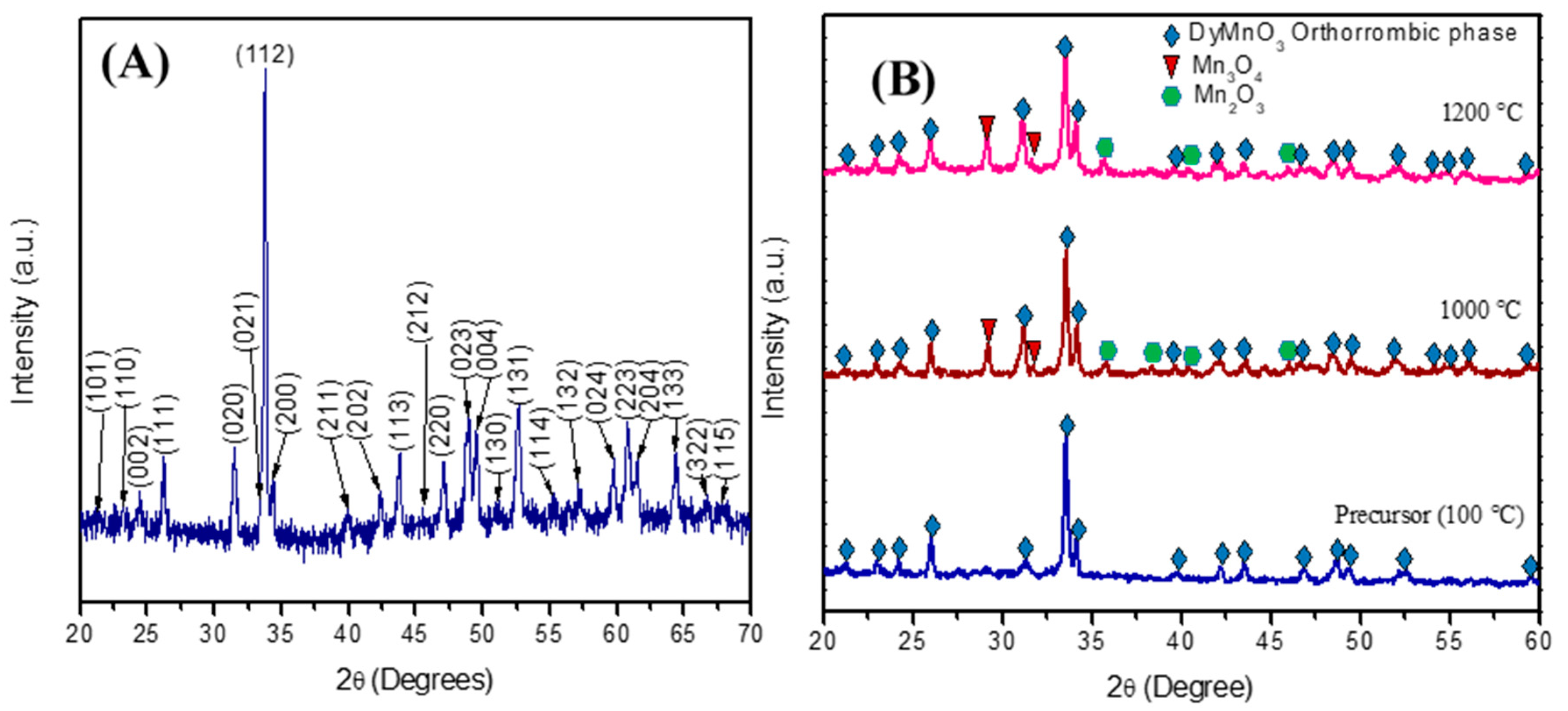
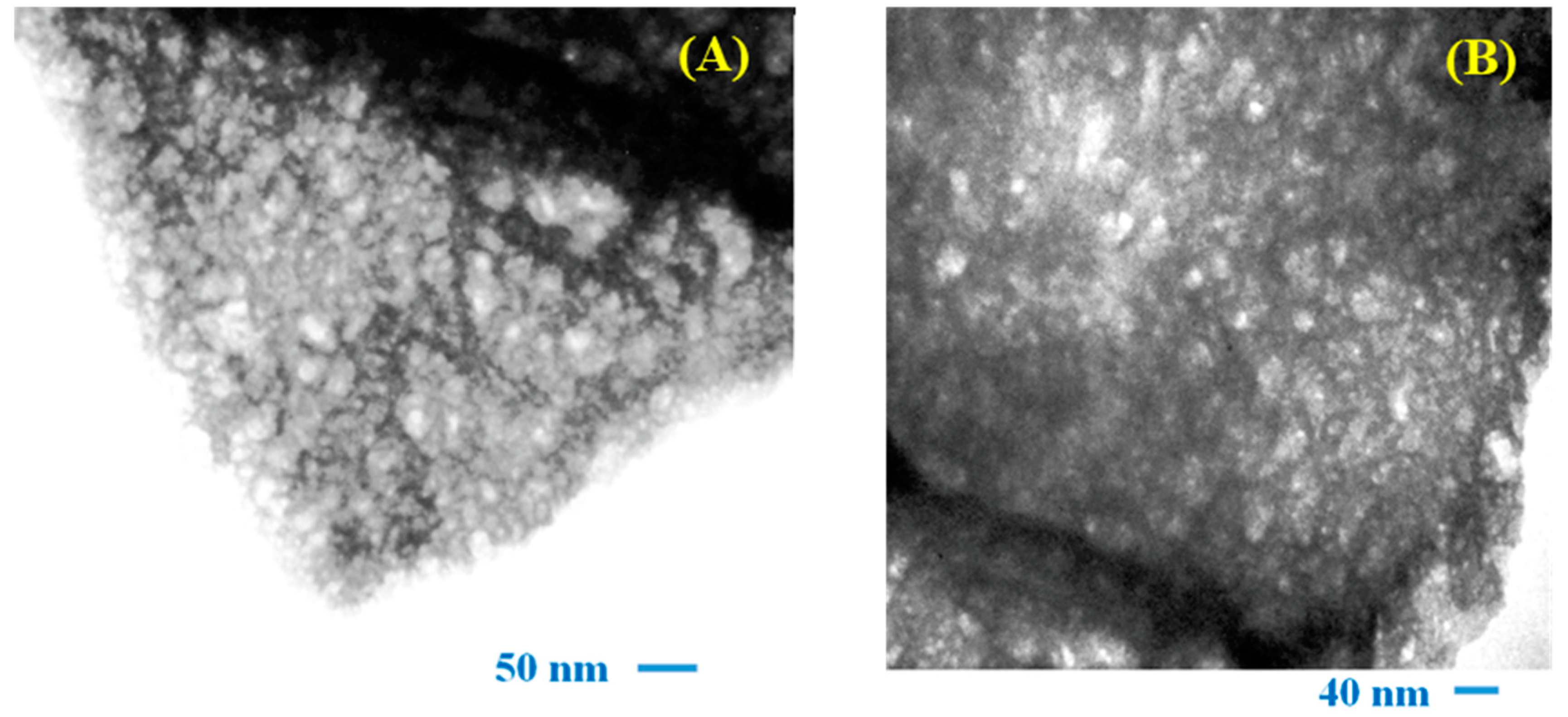
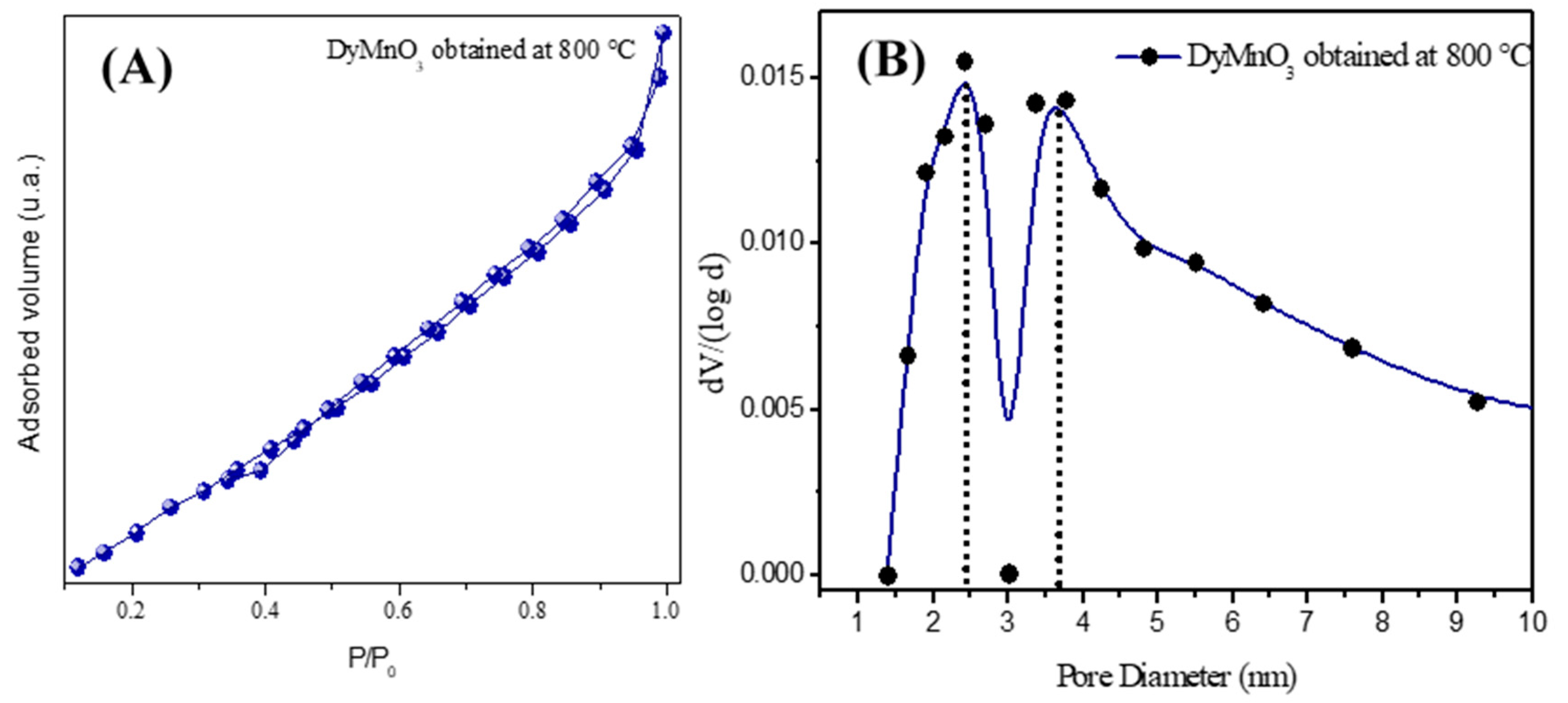
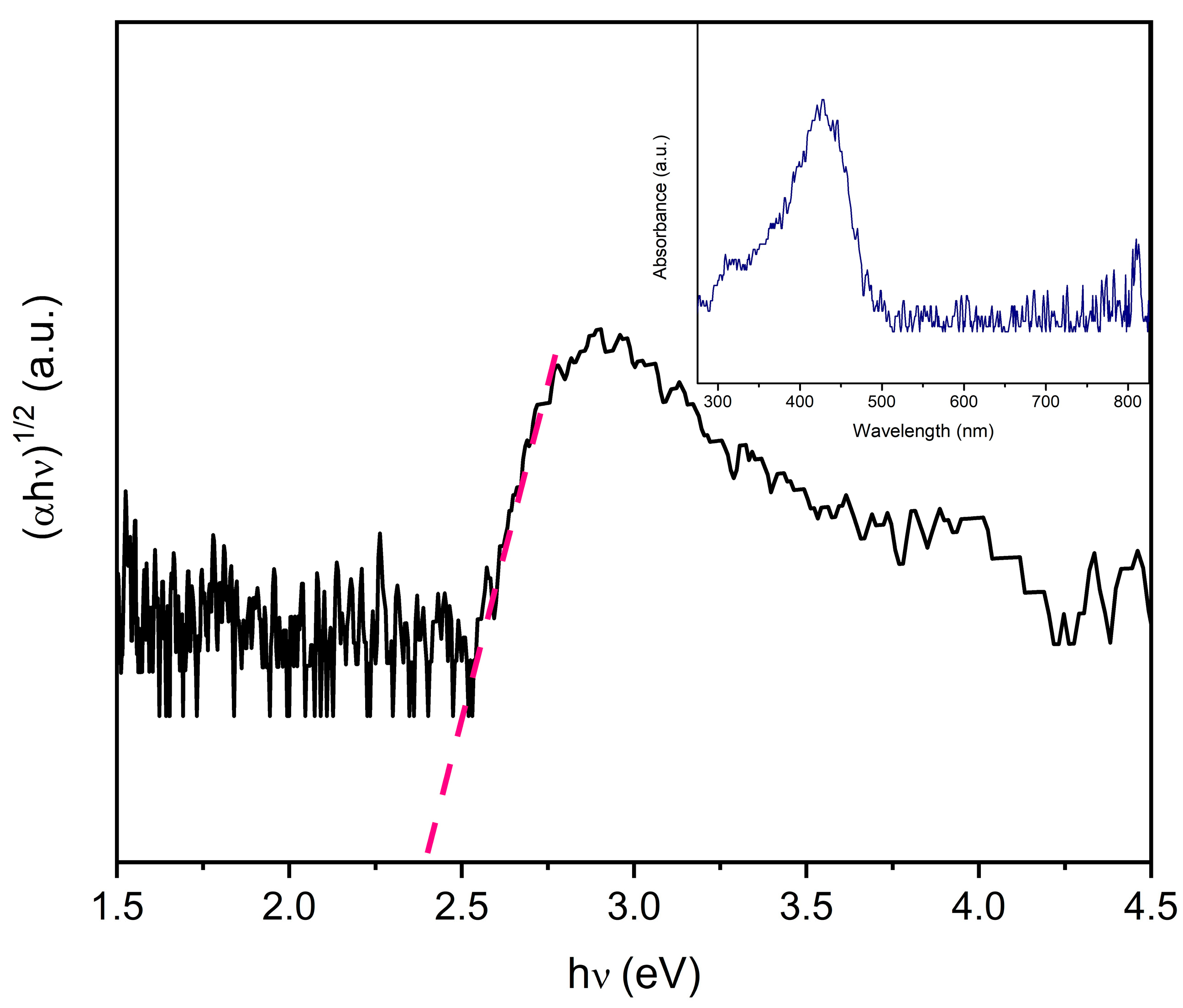
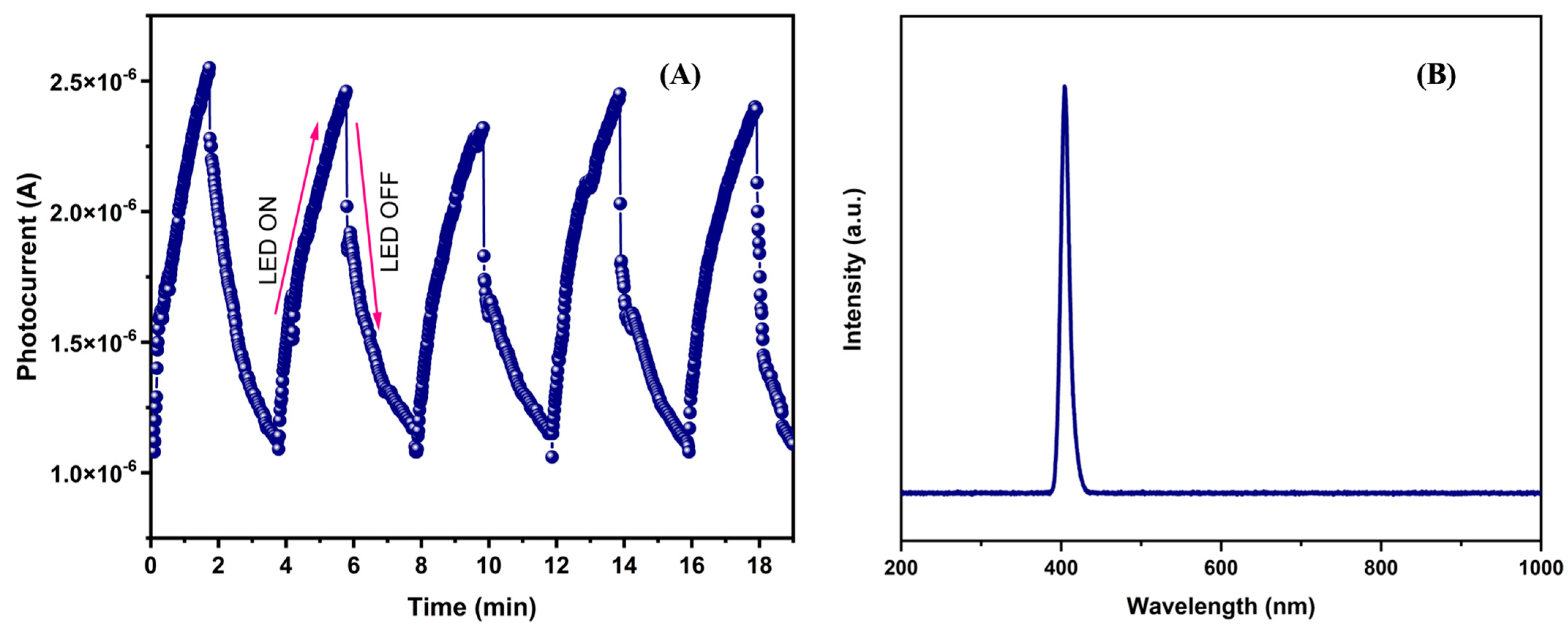


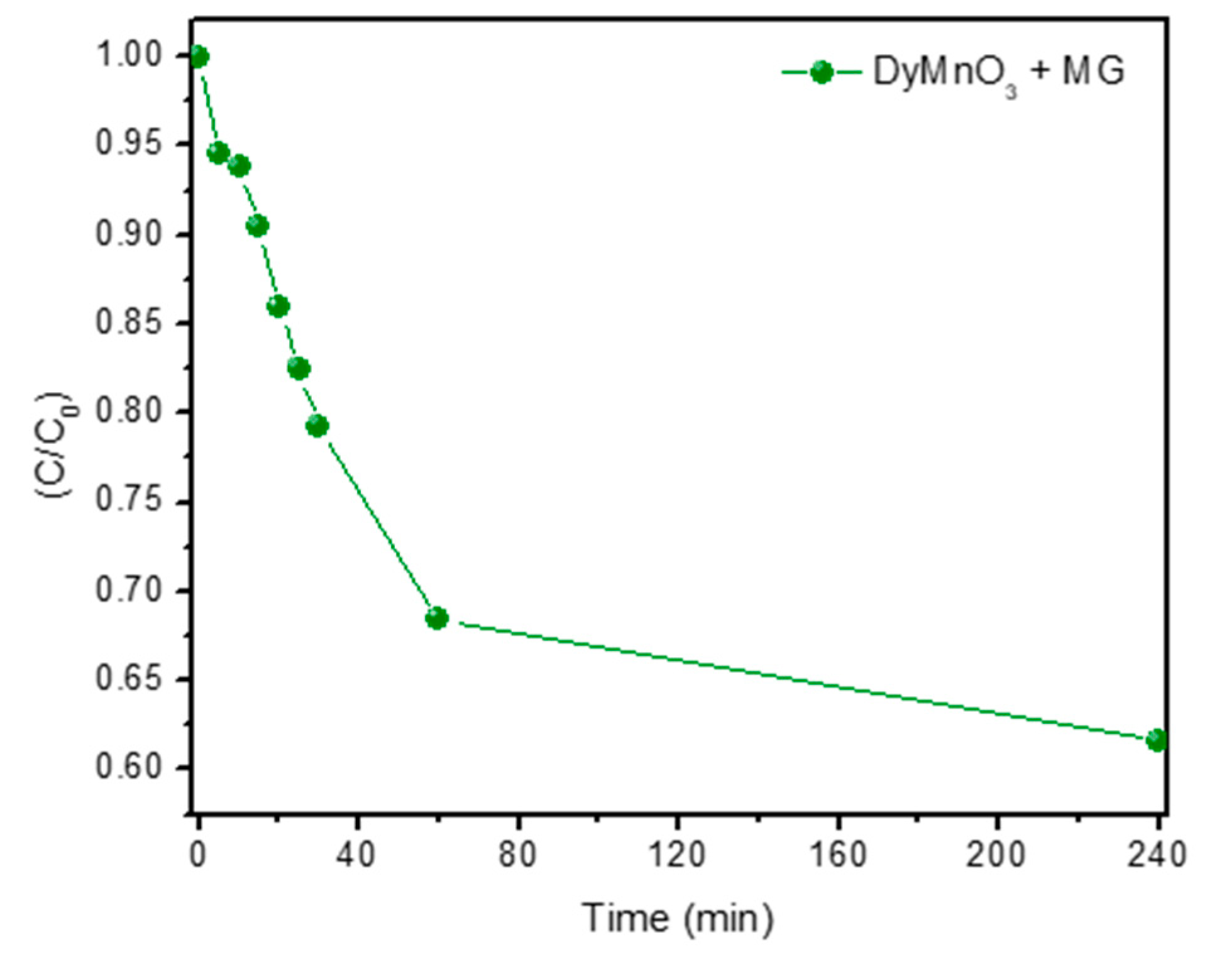


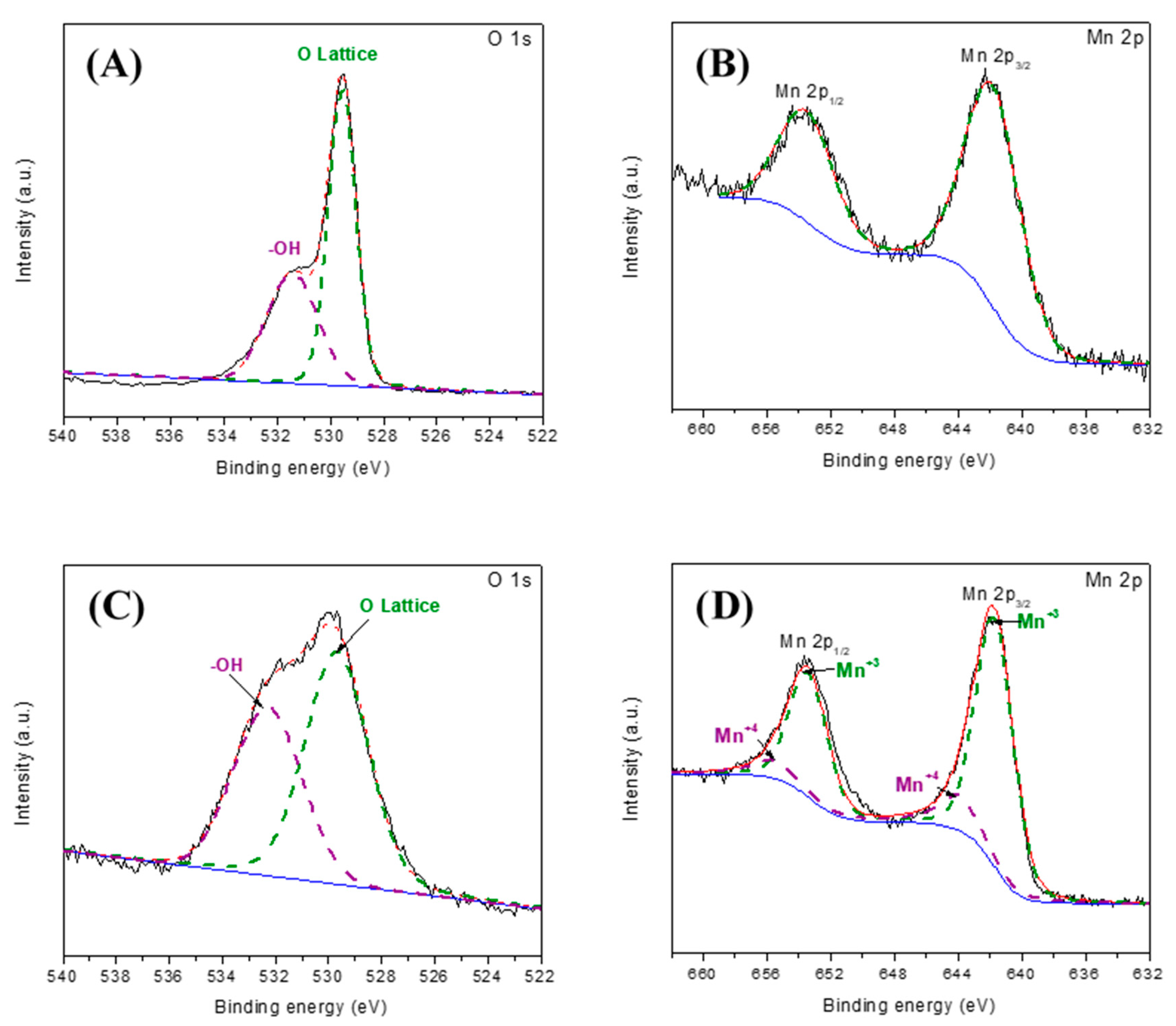
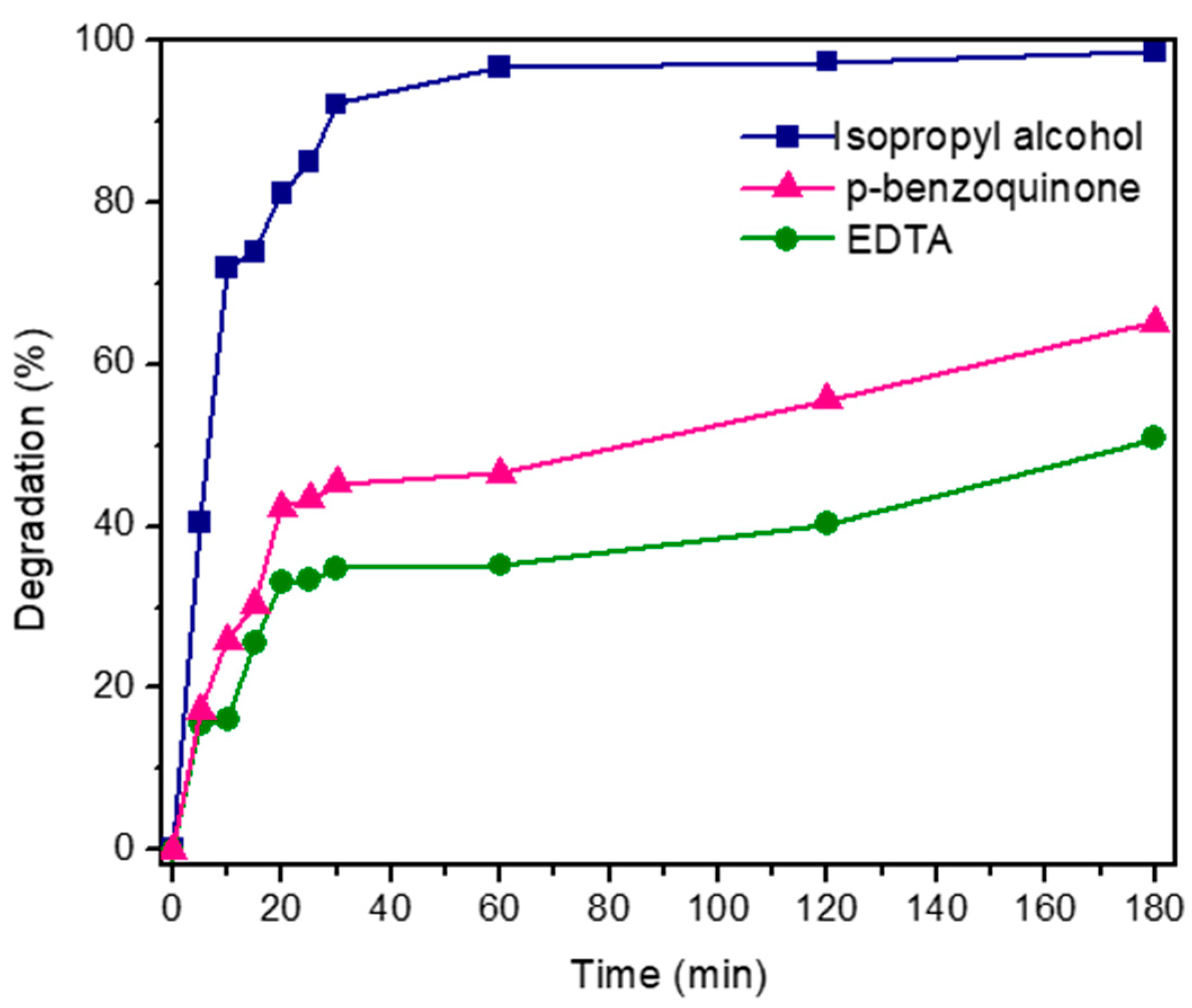
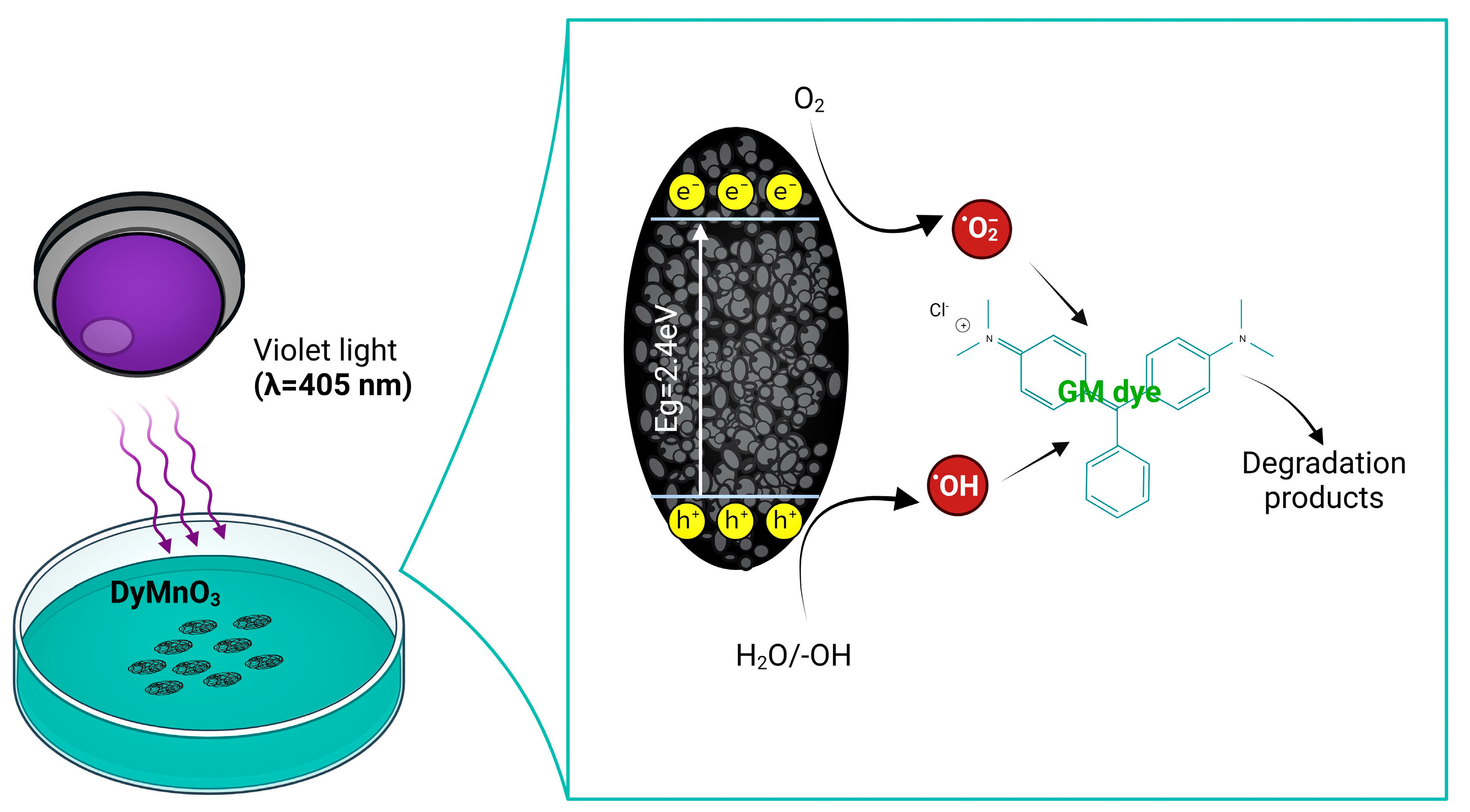
| Material | SBET (m2 g−1) | BJH Total Pore Volume (cm3 g−1) | DR Micropore Volume (cm3 g−1) | BJH Pore Diameter (nm) |
|---|---|---|---|---|
| DyMnO3 | 7.3 | 0.0113 | 0.000128 | 2.4 |
| Photocatalyst | Wavelength (nm) | Amount of Photocatalyst (mg) | Degradation Obtained after 60 min (%) |
|---|---|---|---|
| YMnO3 | 405 | 20 | 20 [7] |
| LaCoO3 | 365 | 10 | 50 [26] |
| DyCoO3 | 365 | 20 | 90 [27] |
| Ga2O3 | 365 | 30 | 10 [28] |
| Photocatalyst | Photocatalyst Amount | Light Type | Irradiation Time (min) | Efficiency |
|---|---|---|---|---|
| ZnO and Dy/ZnO [33] | 80 and 30 mg, respectively | Visible light | 60 | 90% and 100%, respectively |
| Bi2WO6 [34] | 1 g/L (pH = 2) | Visible light | 30 | 87% |
| Fe2O3 (Hematite) [35] | 0.1 g | UV | 180 | 45% |
| NaNbO3 and Au/NaNbO3 [36] | 0.4 g, respectively | Visible light | 60 | 25% and 85%, respectively |
| WO3, TiO2/WO3 [37] | 0.1 g, respectively | Visible light | 60 | 50% and 100%, respectively |
| GO, CuFe2O4, GO/CuFe2O4 [38] | 0.01 g, respectively | Visible light | 210 | 90%, 30% and 63%, respectively |
| WO3 and Pd/WO3 [39] | 150 mg/L, respectively | Solar light | 300 | 50% and 80%, respectively |
| Bi2O3, CaFe2O4, B2O3/CaFe2O4 [40] | 0.05 g, respectively | Visible light | 240 | 70%, 58% and 89%, respectively |
| Fe2O3/SnO2 [41] | 40 mg | Solar light | 240 | 86% |
| ZnO [42] | 0.2 g/L | Solar light | 100 | 85% |
| Co3O4 [43] | 50 mg | Visible light | 100 | 90% |
| Cu2O [44] | 10 mg | Visible light | 45 | 92% |
| DyMnO3 | 40 mg | Visible light | 60 | 93% |
Disclaimer/Publisher’s Note: The statements, opinions and data contained in all publications are solely those of the individual author(s) and contributor(s) and not of MDPI and/or the editor(s). MDPI and/or the editor(s) disclaim responsibility for any injury to people or property resulting from any ideas, methods, instructions or products referred to in the content. |
© 2023 by the authors. Licensee MDPI, Basel, Switzerland. This article is an open access article distributed under the terms and conditions of the Creative Commons Attribution (CC BY) license (https://creativecommons.org/licenses/by/4.0/).
Share and Cite
López-Álvarez, M.Á.; Ortega-Gudiño, P.; Silva-Jara, J.M.; Silva-Galindo, J.G.; Barrera-Rodríguez, A.; Casillas-García, J.E.; Ceja-Andrade, I.; Guerrero-de León, J.A.; López-de Alba, C.A. DyMnO3: Synthesis, Characterization and Evaluation of Its Photocatalytic Activity in the Visible Spectrum. Materials 2023, 16, 7666. https://doi.org/10.3390/ma16247666
López-Álvarez MÁ, Ortega-Gudiño P, Silva-Jara JM, Silva-Galindo JG, Barrera-Rodríguez A, Casillas-García JE, Ceja-Andrade I, Guerrero-de León JA, López-de Alba CA. DyMnO3: Synthesis, Characterization and Evaluation of Its Photocatalytic Activity in the Visible Spectrum. Materials. 2023; 16(24):7666. https://doi.org/10.3390/ma16247666
Chicago/Turabian StyleLópez-Álvarez, Miguel Ángel, Pedro Ortega-Gudiño, Jorge Manuel Silva-Jara, Jazmín Guadalupe Silva-Galindo, Arturo Barrera-Rodríguez, José Eduardo Casillas-García, Israel Ceja-Andrade, Jesús Alonso Guerrero-de León, and Carlos Alberto López-de Alba. 2023. "DyMnO3: Synthesis, Characterization and Evaluation of Its Photocatalytic Activity in the Visible Spectrum" Materials 16, no. 24: 7666. https://doi.org/10.3390/ma16247666







